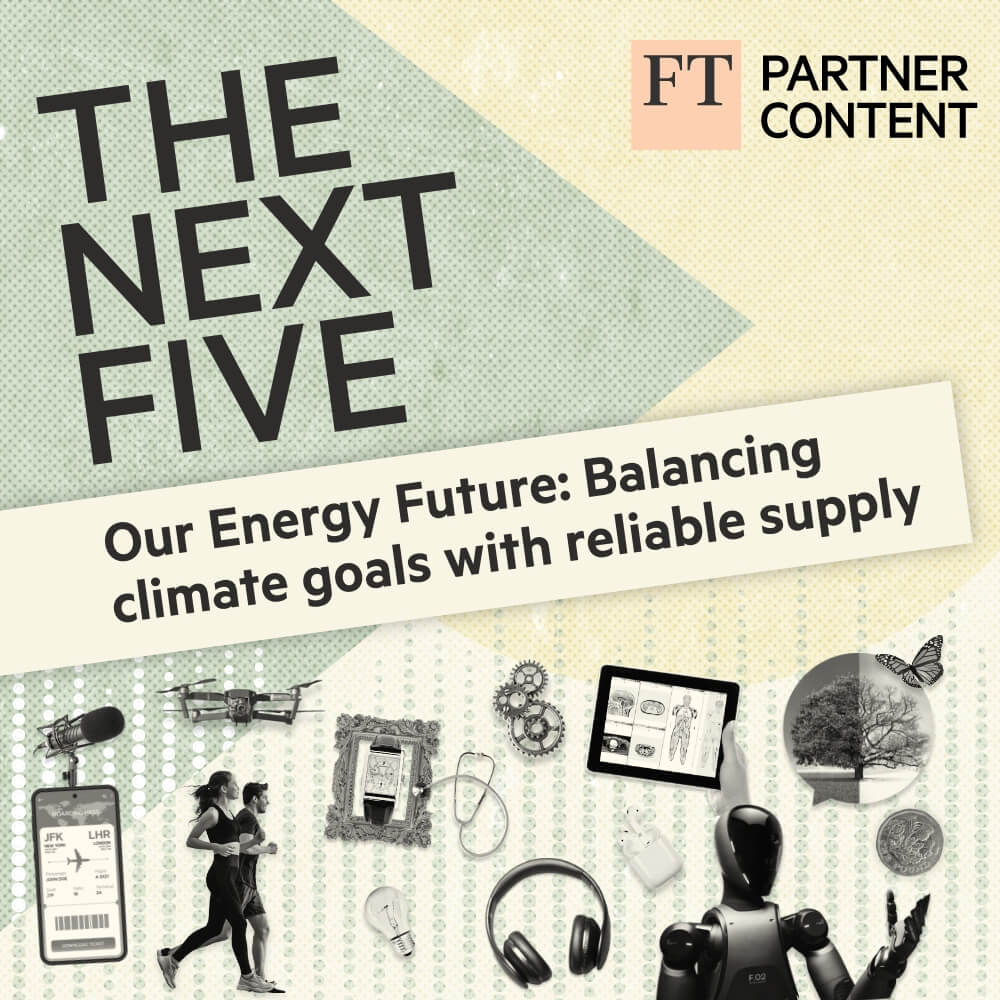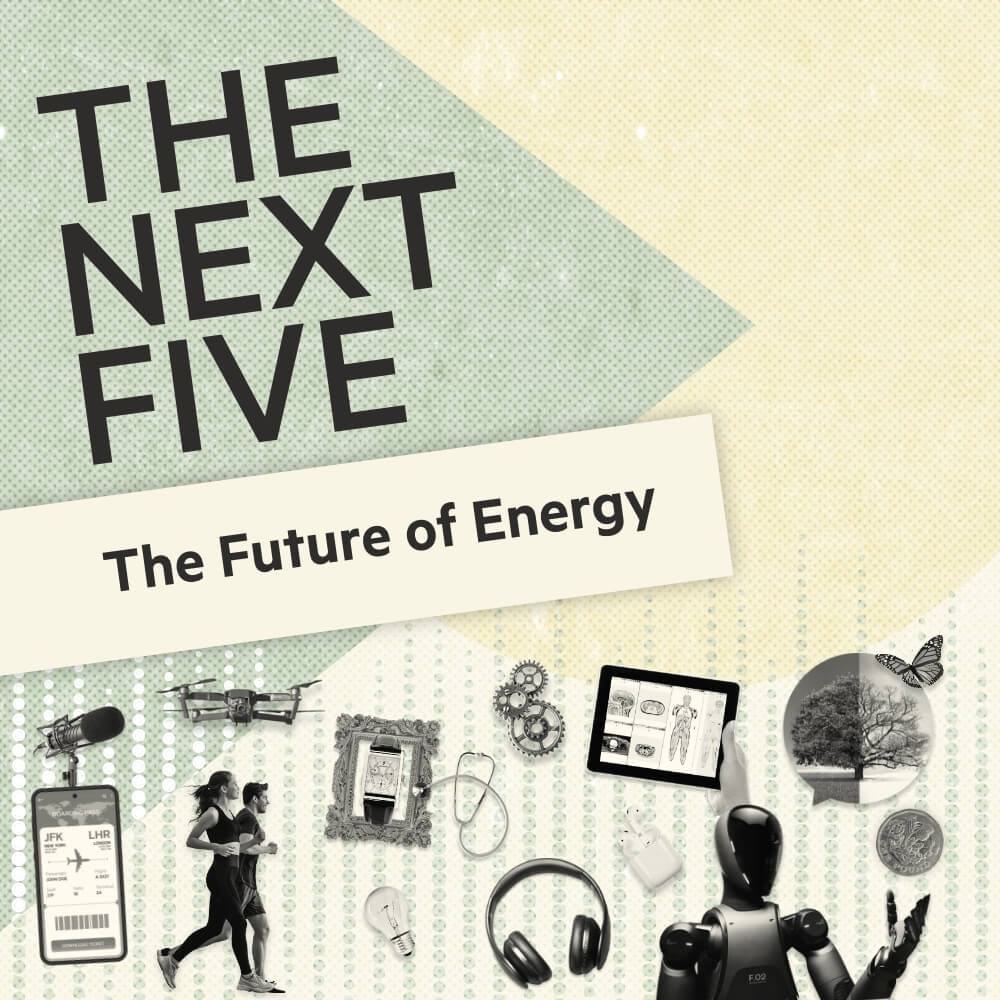THE NEXT FIVE
THE NEXT FIVE - EPISODE 11
Financing the transition to Net Zero
Financing Net Zero: Listen to Chief Economists and Investors tackle the net zero cash flow issue






































The Next Five is the FT’s partner-supported podcast, exploring the future of industries through expert insights and thought-provoking discussions with host, Tom Parker. Each episode brings together leading voices to analyse the trends, innovations, challenges and opportunities shaping the next five years in business, geo politics, technology, health and lifestyle.
















Featured in this episode:
Tom Parker
Executive Producer & Presenter
Tim Gould
Chief Energy Economist at the International Energy Agency
Eirik Waerness
Senior Vice President, Chief Economist and Head of Global External Analysis at Equinor
Nick Stansbury
Head of Climate Solutions at LGIM
Allowing capital flows consistent with a net zero and resilient global economy will require a transformation of the financial system. Since 2016, investments in decarbonisation have been growing at a rate of 5% per annum.
At this rate, the 2050 net zero targets will be missed by 20 years. In this episode of The Next Five, we’re talking about financing the transition to net zero, how capital can be moved towards clean energy, and how industry and government need to collaborate for the world to hit climate goals. Tim Gould, Chief Energy Economist at the International Energy Agency explains where capital is flowing into the global energy market and how much needs to be going into clean energy transition investments to hit climate goals. Eirik Waerness, Senior Vice President, Chief Economist and Head of Global External Analysis at Equinor talks about the need for collaboration between industries and governments and offers a global solution to the carbon pricing debate. Nick Stansbury, Head of Climate Solutions at LGIM, also extols the importance of putting an effective price on carbon as well as calling for a smarter way of managing transition investing.
Our sources for the show: FT Resources, Swiss Re, OBR, OECD, UK Government resources, European Council, US Treasury Department.
This content is paid for by Equinor and is produced in partnership with the Financial Times' Commercial Department.
READ TRANSCRIPT
- Climate
- Finance
Transcript
Financing the transition to Net Zero
TOM:
Allowing capital flows consistent with a net zero and resilient global economy will require a transformation of the financial system.
Tim 01:40 we're up to around $1.7 trillion, going into clean energy transition investments this year.
TOM: But we need to act fast
Nick 25:25 We're not even sure that if you wait till the late 2020s, to try to transition, that is still going to be technically economically possible for us to transition to net zero at all.
TOM: and act collectively
Eirik 34:58
We have to do these things together. Industry business cannot do this alone, will not do this alone.
**CAN WE LEAVE A BIT MORE OF A BREATHE HERE?**
TOM:
I'm Tom Parker, and welcome to the next five podcast brought to you by the FT partner studio. In this series, we ask industry experts about how their world will change in the next five years, and the impact it will have on our day to day. In this episode, we’re talking about financing the transition to net zero, how capital can be moved towards clean energy, and how industry and government need to collaborate for the world to hit climate goals.
Music Fade
TOM:
Since 2016, investments in decarbonisation have been growing at a rate of 5% per annum. At this rate the 2050 net zero targets will be missed by 20 years. With this as a worrying backdrop allowing more capital to flow into the energy sector including different energy projects, from fossil fuels to low carbon and clean energy is imperative. So where are we now and what needs to be done to hit climate goals?
Tim Gould 00:21
That's a big question that we try and look at here at the International Energy Agency.
TOM: This is Tim Gould, Chief Energy Economist at the IEA.
Tim: And as luck would have it, we just released our latest sort of review of these types of capital flows into the energy sector. It's called the world energy investment publication. It's something we do each year. And it's a very dynamic picture. But I think the first thing to have in mind is it wasn't always so dynamic. So if we cast our minds back five years or so there was roughly $2 trillion each year going into global energy. So capital expenditure across all a wide range of areas from fossil fuel supply to renewable some grid infrastructure storage, and also on the demand side, sort of efficiency, investments and electrification. So of that 2 trillion in annual investments, roughly half was going into fossil fuels. And the other half was going into what we will call clean energy. So a range of technologies, including grids and other infrastructure, now, five years on our view is that in 2023, fossil fuels are back where they were so around $1 trillion each year, to this year in supply. But something's changed on the clean energy side. So instead of 1 trillion, we're up to around $1.7 trillion,] going into clean energy transition investments this year. So something's changed. And in our view, what's really changed is that there's been continued momentum behind some of those key clean energy technologies. But effectively, what's happened is that as a result of the pandemic, the response to the pandemic, and the government response, also to the, to the shock of that global energy crisis that we had in 2022, which was intensified by Russia's invasion of Ukraine, that's given an additional boost to clean energy investment.03:32 And there are three or four things behind that one of them is cost. So it is, in many cases, the least cost option for new investment, particularly in power generation. And the second thing has to do with policies. And then we're not just talking about policies around climate. But it's also very much that energy security driver that energy security response to the strains of last year. And then thirdly, I think governments around the world are looking to try and position themselves well in what we might call the emerging clean energy economy. They want good positions in supply chains, they want to have advantageous positions when it comes to deployment and employment. And that's another reason why we're seeing that that shift.
TOM: 01:24 You mentioned 5 years ago the ratio of investment into clean energy was 1-1. Now for every dollar spent on fossil fuels, 1.7 dollars is being spent on clean energy. 01:40 But what does the dollar ratio need to hit by 2030 to meet net zero targets?
Tim Gould 07:37
Right now, as you said, we're on about $1, to fossil fuels 1.7 into a range of clean energy technologies and infrastructure that would need to shift if we're on track for a 1.5 degrees stabilisation in global average temperatures that would need to shift much more radically. So that that $1, in fossil fuel supply investment would be matched by nine times that amount, in a range of clean energy technology. So a much more significant shift.
TOM: 01:56 The gap in investment to meet Paris Agreement climate targets currently stands at $270 trillion dollars according to Swiss Re’s October 2022 report. 02:12 The UK’s largest asset manager, L&G Investment Management (LGIM) that oversees £1.2tn in assets, released a report saying “the world could easily absorb the costs associated with realising the goals of the Paris climate agreement. But the window to successfully meet a 1.5°C climate outcome is closing at a worrying speed.” If the world can absorb the capital required, how do we fill this funding gap and allocate it in time?
Nick Stansbury 22:23
Why have we said with such confidence that we think the world could absorb the costs.
TOM: 02:46 This is Nick Stansbury, Head of Climate Solutions at LGIM and author of the report released by LGIM.
Nick Stansbury 22:34
imagine if we put a jar on our desk, metaphorical jar on our desk.
Nick Stansbury 27:11
and this jar represents the total economic costs, all in every cost associated with transitioning to a net zero energy system. And we fill this jar, by putting one basis point, a jelly bean as it were one basis point of global economic or economic output into that jar every single month. By the time we get to 2050, we haven't filled half the jar, we haven't filled three quarters of the jar. In fact, we've put so many jellybeans into the jar, the jar is overflowing a bit. So a single base point of global economic output into the jar every month, and the jar will be overflowing by the time we get to 2050, we will have more than paid for all of the costs. It's remarkably cheap, because a basis point of volatility and global economic output every month, given all of the other uncertainties that drive volatility in markets and broadly, economies, it tends to be more than two basis points a month. In other words, if you were given two series of economic data, and you were asked to compare them and say, Please tell us which of these is the one where you pay that basis points a month and which are the one is that where you didn't, you'd be unlikely to be able to guess correctly, we think which of the two is the one with and without the costs. So [remove stutter] when we said in the report, we think you need a magnifying glass to see it, we meant it in that we we really do think it is given all of the change that is associated with the system, given all of the enormous levers that we have to pull for the net cost to still turn out to be so low we think is remarkable.
28:53 Especially when you contrast it with the fact that the cost of trying to transition to something that isn't even Net Zero 2050. If we wait till the 2030s to try and do it isn't a handful of percentage points of global economic output cumulatively. It's over 10 percentage points of global economic output and we have to absorb it not over 30 years but over 10.
25:11 And this delayed transition risk, we think is one of the most serious and one of the most underpriced climate related risks out there. We're not even sure that if you wait till the late 2020s, to try to transition, that is still going to be technically economically possible for us to transition to net zero at all.
TOM:03:04 Financing the net zero transition to build a green economy requires more upfront investment than the fossil fuel economy. REMOVE SLIGHT PAUSE Finance is already being mobilised but to build it at speed and scale requires a shift in mindset. Alas, challenges still exist. Whether it is delays in the planning system, a lack of policy clarity, infrastructure bottlenecks or capital waiting for investible propositions, action is required to catalyse the deployment of clean solutions. Sir Isaac Newton once said ‘We build too many walls and not enough bridges.’ A quote used in Equinor’s Energy Perspectives Report 2023 to outline the challenges and opportunities of the energy transition.
EIRIK WAERNESS 04:31
the wall scenario is a forecast.
TOM: 04:01 This is Eirik Waerness, Senior Vice President, Chief Economist and Head of Global External Analysis at Equinor
waltz contains a massive and positive energy transition, both in terms of increased energy efficiency will speed up relative to what we've seen the last 30 years, emissions will come down from the energy sector. In Europe, for instance, emissions will come down between 70 and 75%. From now to 2050. At a global scale, they will only be reduced by 1/3. So the world scenario does not reach climate ambitions, like the one and a half to the target. Unfortunately, And it's because we have too many walls, protecting us against something we don't like. It also locks us in for cooperating in ways that would be globally efficient, if you like and globally, just so and then we've developed another scenario, which is another opportunity, which is, we think, technically possible, but really challenging. We call it bridges. because bridges are open ended, they lead us to places where we otherwise wouldn't have been there or collaborative in their nature. and if you want to reach the one and a half to do target you have we have to build more bridges and build less walls. And in the bridges scenario, what we illustrate there is all the things that have to be done on top of what is happening in the wall scenario.So we have to go net negative in the energy sector globally by 2045, in order to stay within that budget. And that negative means that we take more co2 out of the atmosphere than we put in, which then has to be done with carbon capture and storage, natural carbon sinks, forests, whatever it is, bioenergy with, combined with carbon capture and storage, which then leads to negative emissions 10:26 in current edit (08:31 in Eirik’s original audio) we'll probably also need massive investments in what is called direct air capture where we basically suck the carbon out of the year.
10:28 And finally
And then it's about putting a price on carbon. I mean, what's the market driving instrument that we have here to get investors like us to do it. That's to some extent, it's the avoidance of carbon costs. So we have we have to put the price on carbon which we do in Europe, which we implicitly do in the US states now with the the inflation Reduction Act, but which is significantly lacking and in large parts of the rest of the world.
TOM: 04:15 Eirik mentioned putting a price on carbon. This is a major area of international discussion and one where major challenges exist. Nick, What are the benefits of supporting carbon markets and setting carbon prices and what are the challenges that exist to see a successful carbon market globally?
Nick Stansbury 40:54
So from time to time, I'm asked this question around. Nick, can you give me a list of the top five or the top 10 most impactful measures that policymakers could implement today to accelerate the energy transition?, I've got a top 10 for you. Okay, number one, most important measure bigger than anything else can have more impact on the energy transition than any other policy measure, you could implement guys. We need to put a proper effective, transparent and meaningful price on all greenhouse gas emissions, but especially carbon today. Number two, second most important policy measure, we need to put a meaningful price. when we got down to 10, I've got another 10 for you at number 11. Pricing. And we can get we could go on and on. Let's say by the time we've got down to numbers, 99 or 100, then I've got some other ideas for you. But until we've done one through 100, let's not bother with measure 101, or 100, and T because they're much, much smaller, they're important, they're important, but one to 100, and much more important one to 100, are all exactly the same thing. And that is because the energy system is comprised of an inordinately large number of very, very small moving parts. And today only a tiny fraction, I think fewer than 5% of global emissions are subject to a meaningful price. And most of those are only priced as an ancillary consequence of some other policy decision that has led to putting a tax or a price on on the fossil fuel in question. So whilst all of the petrol that we consume in the UK is subject to a kind of carbon price, it's not there because policymakers wanted to price carbon, it's there because they want to milk the motorists to pay for other things. So not even very much of those emissions are subjected to a carbon pricing mechanism where the level at which that price is applied, is calculated with reference to a proper economic understanding of something like the social cost of carbon. So that damage is the most important and we can talk a great length about compliance carbon markets the role of voluntary carbon markets, but this is hugely important. And policymakers every time we have yet another cop, we sit there eagerly looking. Is this the is this year is this yes now Have you? Once you get past all of those things, then you then start to look at a longer list and start to say, Okay, well, what are some of the other things that policymakers can do? And there are other things that we should be talking to policymakers about. And there are things around time horizons and around putting in place the right sort of incentive structures to incentivize long dated capital allocation decisions, and to incentivize long time horizon thinking about many of these issues and to disincentivize short time horizon issues. Because this time horizon question is, I think, a really big deal when it comes to trying to understand why capital market mispricing of climate risks exists today. But these sorts of things, whilst the very interesting, they have a role to play, they pale into insignificance next to the full impact of proper functioning carbon market that we could and should 13:59 and have. And I think frankly, we'll end up having when the world does start to get serious about driving emissions out of the system.
TOM: 04:35 Tim, your thoughts?
Tim Gould 22:05
So any economist will tell you that if you have a negative externality, if you can put a price on that, then that kind of evens things up, and you'll get sort of rational actors putting money into the things that make sense to, to tackle that issue. And I think there's an important insight there that we all need to have in mind. And many economies are now putting prices on carbon that help to guide investment decisions. But what we're also seeing, particularly in the US, is that there's another approach. So the sort of philosophy around carbon pricing is you make polluting stuff more expensive. Whereas the philosophy of the inflation Reduction Act, is we're going to make the clean stuff cheap. And we're going to do that by offering a subsidy for it. And then it's a very different way of approaching the incentives around transitions. So we have high hopes, I think for all sorts of policy mechanisms, I don't think it seems reasonable to expect that we're going to get a global carbon price anytime soon. The politics around that are just difficult. But I think you're going to have to have a range of incentives, some of them price based, some of them other forms of regulation, in order to move this thing forward.
TOM: 05:19 Eirik, what’s your take?
EIRIK WAERNESS 31:11
we need to put a price on things that we don't want, which is increased emissions. And the flipside of that is that we have to put a price on things that can actually reduce those emissions, which is done carbon sinks or whatever. since carbon emissions has the same global effect, irrespective of where they are, to avoid carbon leakage, to avoid carbon emissions to increase where, where you don't have a price on it, I mean, ideally, of course, we need a global price on carbon where it gets a global market for carbon. And gradually, that can be done indirectly or directly. And it's, of course, extremely difficult to see that that's happening overnight in every country in the world. And especially in a situation where we are not prone to cooperate on anything, right? And the political situation now it's not conducive to addressing climate change or any other global collective challenge. So how do we do it then? Well, you know, the things like getting like a proper carbon border adjustment mechanism in the countries of the world, which are importing a lot of stuff from other countries like EU helps. The Nobel Laureate in economics some years back William Nordhaus are among those that have proposed a carbon club. like the European trading scheme, you make it into a club, if you want to be allowed to import, or to export goods to Europe, without being harmed by the carbon border adjustment, you better become a member of the club by introducing the same type of mechanism in your own home, when your home country. So if the Americans put in place a carbon price in the United States directly or indirectly, they can be allowed to be a member of this carbon club, right. And then you expand that gradually, one way of making it happen.
TOM: 04:42 The USA’s Inflation Reduction Act, 2022 ring fenced $369 billion of investment in clean tech, and France’s ‘France 2030’ and the EU’s ’Fit for 55’ show that there is an international fervour for change at policy level. The UK Infrastructure Bank, one of Britain’s three public financing institutions, has £22bn of financial capacity and a mandate to tackle climate change. So how important is industry collaboration and investment and supportive government policies and funding?
Tim Gould
we think industry collaborations and collaborations also with governments that are going to be absolutely critical to making this work. And I think there we need to focus on the emissions in intensive sectors because that's where the problem is. And that's where we need to be finding solutions quickly. And taking the oil and gas industry as an example. The industry as a whole had a remarkable year last year, in our view, sort of net income for oil and gas producers last year, was close to $4 trillion, which is more than double what it is what it was in the on average in the five years previous to that. So there are there is money available to put into not just traditional supply, but also some of the new solutions that we need.And I think there is a family of technologies that is actually quite a good match for the skills of the oil and gas industry. So when we look at offshore wind, managing projects in those difficult offshore environment, that is clearly something which the oil and gas industry does well. And likewise, all sorts of projects that deal with large scale engineering CCUS, big infrastructure requirements, like getting a hydrogen economy up and running, you know, that is a good match for the sorts of things that the oil and gas industry does well. And so that's when we're really looking to the industry to invest. But those solutions are not going to emerge by themselves, they need some sort of policy support to give the incentives for people to put money into them. And what we're seeing now with the inflation Reduction Act in the US is where those incentives are in place, then investments do come. And there's quite an impressive pipeline now of large scale projects in CCUS, in low emissions, hydrogen in some other areas, and that are responding to that more favourable policy environment today.
TOM: 06:25 Eirik?
EIRIK WAERNESS 34:58
We have to do these things together. Industry business cannot do this alone will not do this alone because we do not have a mandate to lose money. So the things that we invest in and work on, we must have a line of sight to making a buck on this to normal profits. But that's the that's the nature of business. Which is why we need framework conditions that guide us in the right direction. this is also very difficult to see which technology is it that will be the winning one, or the smart one, because we have to test several ones, several technology so government policies that are colorblind, as we say, in the in the choice of hydrogen, whether you like blue or green is not that important. If you wanted hydrogen market, you stimulate hydrogen technology neutral, where we use market based prices or market based type of regulations and do not have politicians or someone else choosing which technology to favour all the time. so it is about doing these things together and that we do this to avoid costs. In the future, we do this to make the energy system and the economy become more efficient, less polluting, less dependent on on geopolitically difficult resources, whether it's oil from the Middle East, or gas from Russia, whatever. So there's a reason why we do this. But it has to be done together. There's a lot quite a bit of research involved here as well, which is typically]in the form of what we economists call a public good. So somebody has to finance it subsidise it for a while. And once it's there, it should be made available for as many as possible. because 20:41 we are rolling that ultimately we're all in the same boat. We're on the same planet here.
TOM: What do the next five years look like? Tim?
Tim Gould 23:58
At the International Energy Agency, we do have a five year outlook. And one of the really striking things that comes from that kind of analysis is when we look at the deployment of renewables. And we've recently released a new five year forecast for renewables, which suggests that over the next five years, we're going to deploy the same amount of renewables as we did during the last 20 years. So that's a very striking indication of the way that these things are scaling up. And I wouldn't be surprised if we exceeded that in practice, because there is a significant amount of momentum, not just on the deployment side, but also on the manufacturing side for some of these clean energy technologies. If you look at the amount of solar PV manufacturing capacity being put in place worldwide, I mean that it goes well above those sorts of deployment levels. So if all of those solar panels are used, then, you know, we could see some upside for those kinds of projections, where I have much less certainty. And where I would like to see much greater progress is on some of the other pillars of a clean energy transition. So, grids low emissions fuels, I mean, that's picking up but it's picking up from a very slow base. And the other thing that's really important to have in mind is improvements in energy efficiency. And there's always so much potential there. And its potential that unfortunately, we don't use as effectively as we should. And then what does that mean, for, in a sense, your fossil fuel investment? Well, we like to see, see those two sides closely interrelated. So the faster we build up a clean energy economy, the less investment we will need in some of those traditional fuels. And what I would also like to avoid is that we get those radically out of sequence, so that we start, phasing down one aspect of our energy economy before we've really built up the rest. Because if we do that, you know, we could be in for a very bumpy ride..
TOM:06:25 EIRIK?
EIRIK WAERNESS 38:41
at least in the beginning of the next five years, what we will see now in terms of financing is of course, a lot of uncertainty related to increase the cost of finance, inflation, and therefore interest rates which makes financing of investments which typically depend on fixed rate of return type of cash flow, slightly, slightly less attractive compared to the alternative which is done to finance a government bond. Right. So so that is one aspect of this. The next five years will also be characterised by the supply chain bottlenecks that we're facing. So uncertainty about how quickly you can actually get access to the necessary stuff. You know, when there's a lot of steel involved in a wind turbine, it's you have the turbine blades, you have the turbine you have a big steel shaft. And if everybody else wants steel at the same time, this is lifting costs. And that's going to slow down the deployment of these types of technologies relative to what we otherwise would have seen. The good news is that since a lot of these investments are positively associated with security of supply constraints. And to some extent, also affordability In a political setting London and then once we have now there's a lot of common push to develop local indigenous energy resources to avoid the dependence on Russia in terms of Europe but also to avoid a dependence on uncertain oil from from the Middle East. Global Energy, global trade and global agreements on anything will will over the next couple of years still be extremely coloured by, lack of trust, by sanctions, and we have a terrible ongoing war in Ukraine, just a few 1000 kilometres away from London, we don't see any obvious signals that that will be over anytime soon. That will colour all the relationships between the large powers in the world. And that ultimately slows down developments in a good direction here. And that's what we're facing the next three, four or five years.
TOM: 06:29 and finally, Nick
Nick Stansbury 48:19
I expect that we're going to continue to see incredible economic and technological progress in many parts of the Low Carbon system, which are going to give us large cause for optimism. I think there are a huge number of things coming down the track, whether that is the progress that's been made in the Hudson industry to drive cost out of hydrogen supply chains, whether we're going to continue to see decarbonisation of electricity, and which I think will continue to take place in lots of the world. So there's, there's lots of areas of optimism and exciting things that I think are going to happen over the next five years. But I expect if we don't see some signs of change pretty soon, that we may start to see in both financial markets, but also in the in the wider societal context, more awareness that we are, if not running out of time, at some point, we will have run out of time. In terms of financial markets. I think there is a growing awareness that the first reaction that we saw amongst investors to engaging with climate change as a factor in investing was overwhelmingly a negative one. People said, our focus should be on what not to finance. I don't want to finance coal. Okay, that that makes sense. I can get behind that. I understand that that makes very logical as to why we don't want to finance that. I don't want to finance oil companies. I don't want to finance carbon intensive industries. I don't want to finance carbon intensive of companies, I don't want to find out certain countries, I don't want to find out certain whole sectors. And we approached it with the climate change black market, right, we went round. And we said, not that not that I don't want that no to that. And that's great in certain ways that that achieved certain things, that will certainly de risk a portfolio for you. And that many of the things you're crossing out with black market pen or some of the areas of markets, which do evidentially look to be some of the most risky and vulnerable to some of the long term financial consequences of the energy transition. But at the same time, taking money away from a company or an industry that needs to allocate a large quantity of capital towards decarbonisation does not intuitively and obviously seem like the sort of thing which is going to incentivize them to decarbonize. So 26:34 [a strange drop off here] in the steel industry, we need a huge amount of capital to decarbonize, and what do investors say, I don't want to finance you. Because I want to have an impact. not obvious that that was ever going to have the effect that we wanted it to have. And I think that is starting to change. And I'm really excited and encouraged by the fact that I see all around me in the world of climate change investors, people starting to grapple with this question of, okay, if the answer is not no, what is the answer instead, if we're not going to solve this problem, by taking out the black market pen and crossing things out, then we need to instead start to embrace something diametrically opposed to that, which is where we say, you are not perfect today. But they're nowhere in the world is because otherwise, we wouldn't be having this conversation, we can see that you need to do a certain series of things in order to transition successfully, that if you do not that there will be financial risks associated with it. And if you do it in a more efficient, more effective, faster and better way than your peers do, that there will be some financial opportunities for me as an investor, and starting to embrace this question of transition investing, where rather than pulling out the black market pen, we instead, pull out the magnifying glass and we start going hunting for the places where we can deploy capital positively to make a positive decision to drive impact and unlock long term value for our clients is, I think, a really, really exciting way forward. And there are some signs around us, I think that more and more investors are starting to engage with that way of thinking about financing the energy transition. And from my perspective, we couldn't confine the black market pan to the bit and fast enough. So I'm really excited about that.
TOM OUTRO: 05:32
In March 2023, the UN secretary-general António Guterres said in the UN IPCC climate report, “1.5°C is achievable. But it will take a quantum leap in climate action.”
It’s pretty clear to see that action is happening. We’ve made progress over the last few years, 1.7 dollars is going into clean energy transition investments for every dollar into fossil fuels. But, more money is needed. 07:00 what we’ve learnt today, is that if industries and countries form a carbon club setting a global price on carbon, and if clear, consistent government policy and incentives exist 07:15 then the path to the transition can pick up the required pace.
Also if there is more than enough capital in the world to hit climate targets, 07:27 if we fill the metaphorical jelly bean jar little by little before it’s too late.








